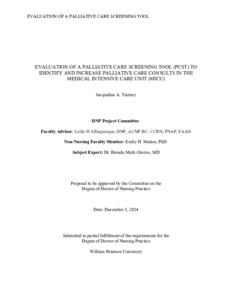Please use this identifier to cite or link to this item:
http://hdl.handle.net/20.500.12164/3470Full metadata record
| DC Field | Value | Language |
|---|---|---|
| dc.contributor.author | Tierney, Jacqueline Anne | - |
| dc.date.accessioned | 2024-12-20T19:36:57Z | - |
| dc.date.available | 2024-12-20T19:36:57Z | - |
| dc.date.issued | 2024-12-05 | - |
| dc.identifier.uri | http://hdl.handle.net/20.500.12164/3470 | - |
| dc.description.abstract | Introduction and Background: Palliative care (PC) is a fundamental aspect of holistic and patient-centered care that aims to anticipate, prevent, and manage all aspects of suffering to improve the overall quality of life for patients, their families, and caregivers (National Institute of Health, 2021). There is a significant demand for PCs in intensive care units (Brunker et al., 2023). Objectives: This project aimed to assess the impact of incorporating the Palliative Care Screening Tool (PCST) to identify patients admitted to the MICU in a large academic medical center with unmet Palliative Care needs and to increase the timeliness of Palliative Care consultations. Hypothesis: Implementing the PCST will identify patients with unmet palliative care (PC) needs and increase the number of PC consults. Methodology: A retrospective chart review of patients admitted or transferred to the MICU over 15 months to gather demographic information and compare patients eligible for a PCC based on their PCST score to the actual number of consultations received. Results: A total of one hundred and sixty-two charts were reviewed, and 110 patients (67.9%) received a positive PCST score, indicating their eligibility for a consultation. Among those eligible, only 47 patients (42.7%) received a consult, while 63 eligible patients (57.3%) did not. An independent t-test showed that those with a PCC had mean total comorbidities .781 higher than those who did not have a consult (t=3.471; p<.001). A crosstabulation shows that 44% of those with cardiac comorbidities were noted as having a PCC vs. 23% who did not (χ2 = 7.205, p=.007). Conclusion: It is important to integrate palliative care consults as a trigger on an ongoing basis to increase the number of patients receiving one while hospitalized. | en_US |
| dc.format.extent | 68 pages | en_US |
| dc.language.iso | en_US | en_US |
| dc.publisher | William Paterson University | en_US |
| dc.subject | Nursing | en_US |
| dc.subject | ICU | en_US |
| dc.subject | Palliative care | en_US |
| dc.subject | Screening tool | en_US |
| dc.subject.lcsh | Nursing | en_US |
| dc.title | Evaluation of a Palliative Care Screening Tool (PCST) to Identify and Increase Palliative Care Consults in the Medical Intensive Care Unit (MICU) | en_US |
| dc.type | Dissertation | en_US |
| Appears in Collections: | Theses & Dissertations | |
Files in This Item:
| File | Description | Size | Format | |
|---|---|---|---|---|
| Tierney_PCST.pdf | 1.55 MB | Adobe PDF |  View/Open |
Items in DSpace are protected by copyright, with all rights reserved, unless otherwise indicated.
